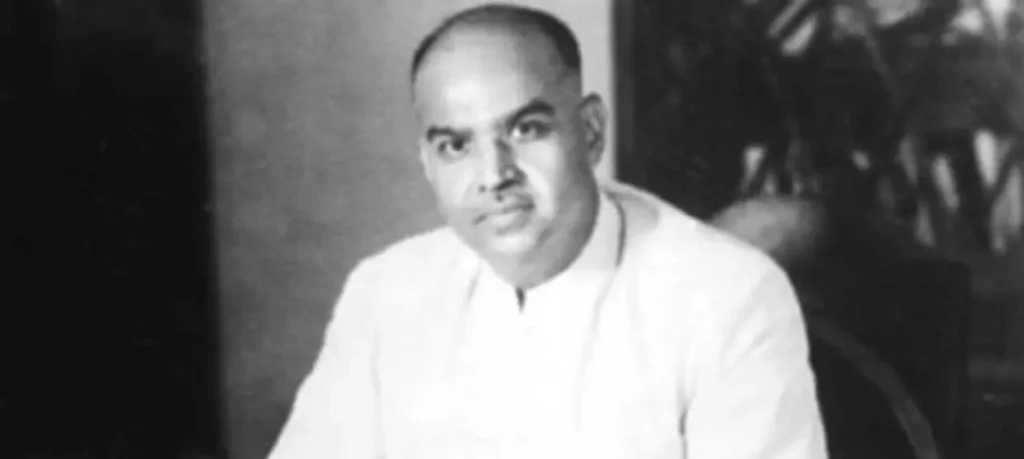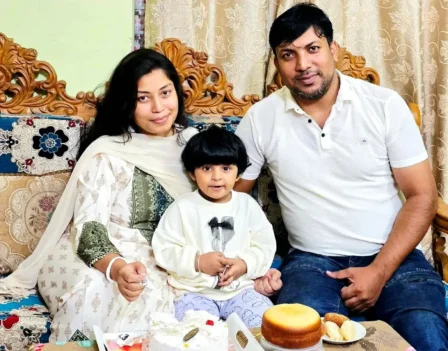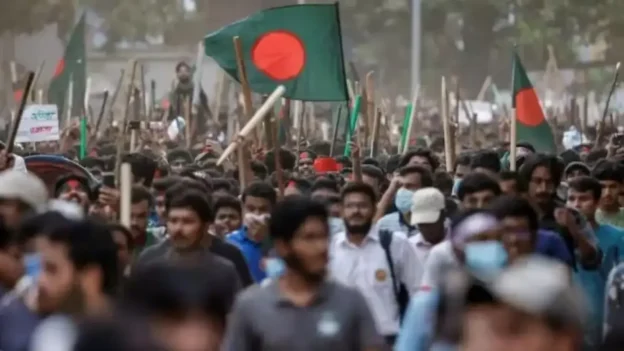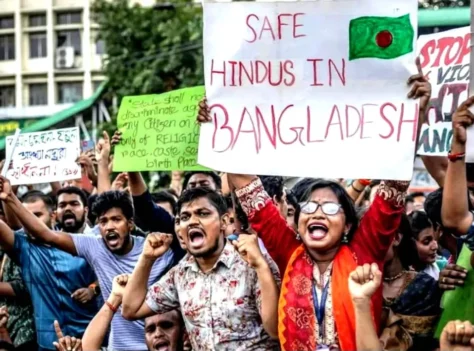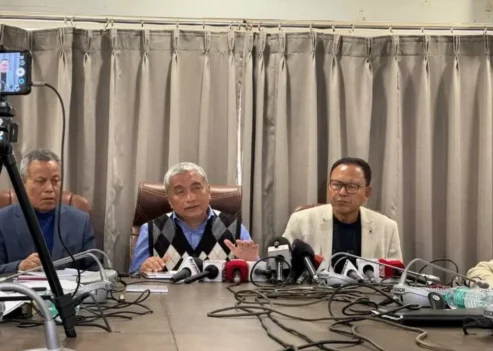It was a small gathering of distinguished guests at the Kanaklal Barua auditorium in the historic city of Guwahati, where a great patriot, educationist, statesman, and fearless campaigner for national unity and integrity was honoured by recollecting his exceptional contributions to the country and its people. Organised by the city-based regional centre of Indira Gandhi National Centre (IGNCA) for the Arts in collaboration with the Assam Directorate of Museums and Indigenous and Tribal Faith and Culture on 31 July 2025, the lecture ‘Remembering Dr Syama Prasad Mookerjee: Nationhood, Identity and the North East’, on his 125th birth anniversary, unfolded many pages of history covering India’s pre- and immediate post-independence days.
Gracing the function as chief guest, the illustrious Assamese cultural personality Pranjal Saikia paid tribute to SP Mookerjee for his unconditional support to Assam and Asomiya society in a critical juncture of time. Earlier, the sacred bonti (lamp) was lit in front of a Mookerjee portrait by the distinguished guests in the presence of IGNCA Regional Centre director Dr Sapam Ranabir Singh.
Amid surrounding myths about Dr Mookerjee being a hardcore Hindu fanatic, it was highlighted that he was associated with a number of socio-cultural organisations, namely the Mahabodhi Society of India and Nikhil Bharat Banga Sahitya Sammelan, among others. Pursuing a brilliant academic career, Mookerjee became the youngest vice-chancellor of Calcutta University in 1934 at the age of 33. Rabindranath Tagore was invited to the 1937 Calcutta University convocation, where Kobiguru delivered his lecture in Bengali—for the first time at the acclaimed institution under Mookerjee’s mentorship. Starting his political career in 1929 as a member of the Indian National Congress, Mookerjee served in both provincial and central governments as minister.
Born into a Kolkata Bengali Hindu family (to renowned law luminary Ashutosh Mookerjee and Jogmaya Devi) on 6 July 1901, Syama Prasad was a brilliant student from his early days. He topped all examinations in Matriculation (1917), graduation (1921), and post-graduation (1923). Most significantly, he chose Bengali for his MA at Calcutta University, despite his proficiency in English. Soon after his father’s demise in 1924, Syama Prasad began practising as an advocate in Calcutta High Court and later became a qualified barrister in 1927 in England. Married to Sudha Devi, Syama Prasad had a conjugal life for only 11 years, and the couple left behind two sons (Anutosh and Debatosh) and two daughters (Sabita and Arati).
With consultation and support from the Rashtriya Swayamsevak Sangh (then chief Madhav Sadashiv Golwalkar), he founded the Bharatiya Jana Sangh, a political party with a nationalist outlook, in 1951 after leaving the Hindu Mahasabha. Notably, today’s Bharatiya Janata Party was formed from the Jana Sangh in 1980. Earlier, Mookerjee resigned from the Jawaharlal Nehru-led interim central government in New Delhi as industry and supply minister, opposing the 1950 agreement with then-Pakistan Prime Minister Liaquat Ali Khan (which allowed J&K to maintain special status and a separate flag). Mookerjee was later elected to the first Lok Sabha after the 1952 general elections as a Jana Sangh candidate.
A passionate believer in India’s integrity who launched a nationwide campaign against Partition, Mookerjee later insisted on retaining Hindu-majority areas of Bengal (as well as present Punjab) with India, as the birth of Muslim-dominated East & West Pakistan became inevitable. He strongly demanded that the western portion of Bengal (now West Bengal/Paschim Banga) be retained for Hindu Bengalis from the clutches of the Muslim League. As a designated speaker in the meeting, I asserted that credit should go to Mookerjee for West Bengal being an integral part of India and that he should be regarded as the founder of Paschim Banga. Moreover, had the entire Bengal gone to East Pakistan, the north-eastern region would have been completely isolated from the rest of India (not even connected by the narrow Siliguri corridor).
Opposing the then-prevailing permit system to enter Jammu & Kashmir, Mookerjee marched to the frontier province and was arrested on 11 May 1953 while crossing the border. During his days in Srinagar jail he fell ill and died under mysterious circumstances on 23 June 1953. Shockingly, no postmortem was carried out, and the authorities did not allow the body to be taken to New Delhi (rather flown to Calcutta directly). Even after repeated requests from his mother, along with many prominent individuals for an inquiry into Mookerjee’s unexplained death, PM Nehru did not allow it. Thus, an articulate son of Bharat laid down his life to remind us that every Indian must be governed by the same set of guidelines and also benefited equally by welfare schemes.
Addressing the gathering, another speaker Mita Nath Bora, a researcher on Dr Mookerjee and prolific writer, commented that among the galaxy of freedom fighters, if there is one great fighter whom we (read Assam) should be thankful to for being part of India, it is him. His foresight and fight helped Assam remain in India instead of being a part of East Pakistan (now Bangladesh) during Partition. Dr Mookerjee’s role (along with that of Netaji’s elder brother Sarat Chandra Bose) in saving Assam from Pakistan is officially recorded. Great Assamese freedom fighter Pushpalata Das stated that Assam could not have been saved from being merged with East Pakistan by Gopinath Bordoloi and a few freedom fighters alone, if Dr Mookerjee had not actively voiced out, strategised, and fought for the cause, she added.
“If we are happily living a secure, peaceful life in Assam today, we should be thankful and grateful to Dr Mookerjee. Otherwise, we could have been on the other side of the border and remained among the 8% of the surviving Hindu population in Bangladesh. Dr Mookerjee travelled to several parts of Assam and experienced Assamese lifestyle. He also advocated for Asomiya to be the official language of Assam. Such was his love and affection for Assam and Asomiya society. After becoming vice-chancellor of Calcutta University, Dr Mookerjee (following his father’s footsteps, who first introduced Assamese language and literature under the Modern Indian Language section at Calcutta University) continued promoting the language in different ways. During his tenure, Dr Birinchi Kumar Baruah was appointed as the first Assamese educator at the prestigious university to teach Asomiya. He often urged non-Assamese residents in Assam to appreciate and learn Asomiya,” said Ms Bora.
Dr Nilima Bhagabati, retired professor of Gauhati University, who chaired the event, termed SP Mookerjee a courageous son of Bharat, who did not hesitate to speak the truth irrespective of any consequences. The award-winning academician and vice-president of Akhil Bharatiya Sikshan Mandal, Prof Bhagabati, profoundly stated that SP Mookerjee sacrificed his life for the unity and integrity of the motherland. His clarion call for rejecting two constitutions and two flags in one country (referring to Jammu & Kashmir) made ripples among ordinary Indians. Mookerjee put his life at risk, not to speak of his political career, to protect and unite the country. A member of National Education Policy-2020, Dr Bhagabati concluded the session by urging young people to study and realise the sacrifice of millions of known and unknown freedom fighters to make India a sovereign nation.

